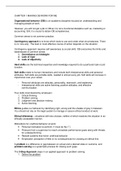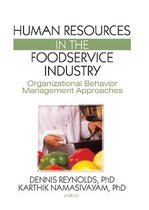CHAPTER 1 MAKING OB WORK FOR ME
Organizational behavior (OB) is an academic discipline focused on understanding and
managing people at work.
However, you will not get a job in OB as it is not a functional discipline such as, marketing or
accounting. Still, it is crucial to obtain OB competencies.
Common sense is not common practice.
Contingency approach is to know which tools to use and under what circumstances. There
is no ‘one way’. The best or most effective course of action depends on the situation.
Contingency approach requires self-awareness (a crucial skill). OB overcomes the limits and
weaknesses of common sense:
1. Overreliance on hindsight
2. Lack of rigor
3. Lack of objectivity
Hard skills are the technical expertise and knowledge required to do a particular task or job
function.
Soft skills relate to human interactions and include both interpersonal skills and personal
attributes. Soft skills are portable skills, needed in almost every job. Soft skills will increase in
importance over your career.
- Personal attributes are attitudes, personality, teamwork, and leadership.
- Interpersonal skills are active listening, positive attitudes, and effective
communication.
Four skills most desired by employers:
1. Critical thinking
2. Problem solving
3. Judgment and decision making
4. Active listening
Ethics guides our behavior by identifying right, wrong and the shades of grey In between.
You should not rely on the legal system to manage or assure ethical conduct at work.
Ethical dilemmas = situations with two choices, neither of which resolves the situation in an
ethically acceptable manner.
Motivations for unethical behavior at work:
• Personal motivation to perform (“I must be No.1”)
• Pressure from a supervisor to reach unrealistic performance goals along with threats
for underperforming
• Reward systems that honor unethical behavior
• Employees’ perception of little or no consequences for crossing an ethical line.
A problem is a difference or gap between an actual and a desired state or outcome, and
problem solving is a systematic process for closing such gaps.
The 3-Step Approach steps in an applied approach to problem solving:
1. Define the problem
, - Define problems in terms of desired outcomes, then test each one by asking, “Why is
this a problem?”
2. Identify potential causes using OB concepts and theories
- Test your causes by asking, “Why or how does this cause the problem?”
3. Make recommendations and (if appropriate) take actions.
- Map recommendations onto causes.
Person factors are the infinite characteristics that give individuals their unique identities.
Situation factors are all the elements outside us that influence what we do, the way we do
it, and the ultimate results of our actions.
The interactional perspective states that behavior is a function of interdependent person
and situation factors.
Workplace behavior occurs at three levels: individual, group/team, and organizational.
- People and situations change each other.
- Personal and situational factors are the initial drivers of all outcomes.
How to select the best option: first decide, do you want to be the problem resolved, solved, or
dissolved?
▪ Resolving = a temporary solution that works but will not last and is not ideal.
▪ Solving = the optimal response.
▪ Dissolving = requires changing or eliminating the situation in which the problem
occurs.
Three common elements that will help you qualify the best solution:
1. Selection criteria
2. Consequences
3. Choice process
CHAPTER 2 INDIVIDUAL DIFFERENCES AND EMOTIONS
Individual differences (IDs) are the many attributes, such as traits and behaviors, that
describe each of us as a person.
Intelligence represents an individual’s capacity for constructive thinking, reasoning, and
problem solving.
Gardner’s eight intelligences:
➢ Linguistic intelligence
Potential to learn and use spoken and written languages.
➢ Logical-mathematical intelligence
Potential for deductive reasoning, problem analysis, and mathematical calculation.
➢ Musical intelligence
Potential to appreciate, compose, and perform music.
➢ Bodily-kinesthetic intelligence
Potential to use mind and body to coordinate physical movement.
➢ Spatial intelligence
Potential to recognize and use patterns.
➢ Interpersonal intelligence
Potential to understand, connect with, and effectively work with others.
➢ Intrapersonal intelligence
, Potential to understand and regulate yourself.
➢ Naturalist intelligence
Potential to live in harmony with your environment.
Practical intelligence is the ability to solve everyday problems by utilizing knowledge gained
from experience in order to purposefully adapt to, shape, and select environments.
Personality is the combination of stable physical, behavioral, and mental characteristics that
gives individuals their unique identities.
These characteristics or traits – including the way we look, think, act, and feel – are the
product of interacting genetic and environmental influences and are stable over time and
across situations and cultures. Personality is a person input in the organizing framework.
The Big Five Personality Dimensions simplify more complex models of personality.
The dimensions are:
1. Extroversion
Characteristic: outgoing, talkative, sociable, assertive.
2. Agreeableness
Characteristic: trusting, good-natured, cooperative, softhearted
3. Conscientiousness
Characteristic: dependable, responsible, achievement-oriented, persistent
4. Emotional stability
Characteristic: relaxed, secure, unworried
5. Openness to experience
Characteristic: intellectual, imaginative, curious, broad-minded
A proactive personality is an attribute of someone ‘relatively unconstrained by situational
forces and who effects environmental change. Proactive people identify opportunities and act
on them, show initiative, take action, and persevere until meaningful change occurs.’
Major reasons organizations use personality tests:
- Reduce time and cost of recruiting and hiring
- Reduce biases in the interview process
- Increase the pool of candidates
- Complement candidate information found in resumes and interviews
Experts argue that the typical personality test is not a valid predictor of job performance
because test takers don’t describe themselves accurately but instead try to guess what
answers the employer is looking for.
Core self-evaluations (CSEs) represent a broad personality trait made up of four narrow
and positive individual traits:
1) Generalized self-efficacy
2) Self-esteem
3) Locus of control
4) Emotional stability
1) Self-efficacy is a person’s belief about his or her chances of successfully accomplishing a
specific task.
Ways to apply knowledge of self-efficacy at work:
• Job design
• Training and development
, • Self-management
• Goal setting and quality improvement
• Creativity
• Coaching
• Leadership
2) Self-esteem is your general belief about your own self-worth.
Self-esteem may depend on:
- Nationality
- Life span
- Gender
3) Locus of control is a relatively stable personality characteristic that describes how much
personal responsibility we take for our behavior and its consequences.
➢ Internal locus of control refers to people who believe they control the events and
consequences that affect their lives
➢ External locus of control refers to those who believe their performance is the
product of circumstances beyond their immediate control possess
4) Emotional stability; individuals with high levels of emotional stability tend to be relaxed,
secure, unworried, and less likely to experience negative emotions under pressure. In
contrast, if you have low levels of emotional stability, you are prone to anxiety and tend to
view the world negatively.
Is more always better? → emotional stability increases but only to a point.
o Effect on organizational citizenship behaviors
An increase in emotional stability causes a decrease in OCBs, likely because you
focus your attention on the task at hand and not on your coworkers.
o Effect on counterproductive work behaviors
Emotional stability buffered or protected participants against stressors at work,
cannot prevent counterproductive behaviors.
Emotional intelligence (EI) is the ability to monitor your own emotions and those of others,
to discriminate among them, and to use this information to guide your thinking and actions.
Emotional intelligence is a mixture of personality and emotions and has four key
components:
Personal competence
1. Self-awareness
2. Self-management
Social competence
3. Social awareness
4. Relationship management
Emotions are complex, relatively brief responses aimed at a particular target, such as a
person, information, experience, or event. They also change psychological and/or
physiological states. Researchers distinguish between felt and displayed emotions.
Emotions to goal achievement:
▪ Positive → congruent with your goal
▪ Negative → incongruent with your goal
▪ Mixed → consideration between factors





